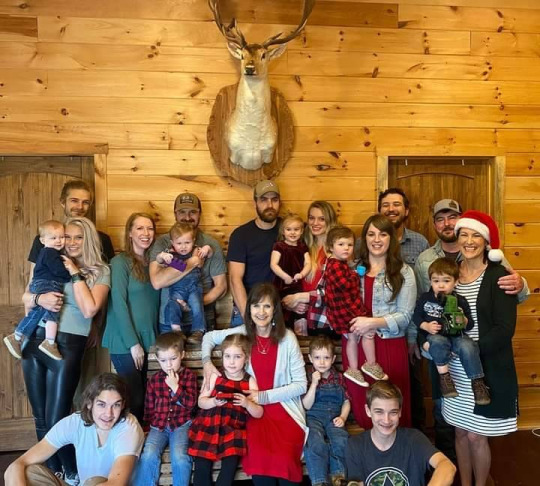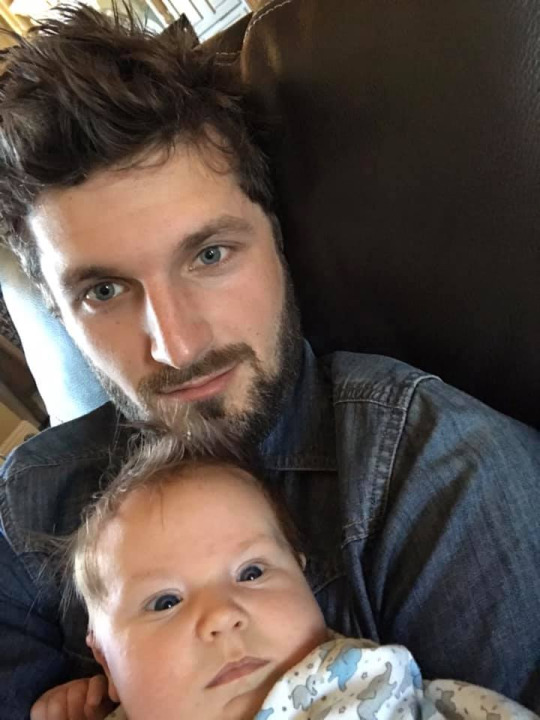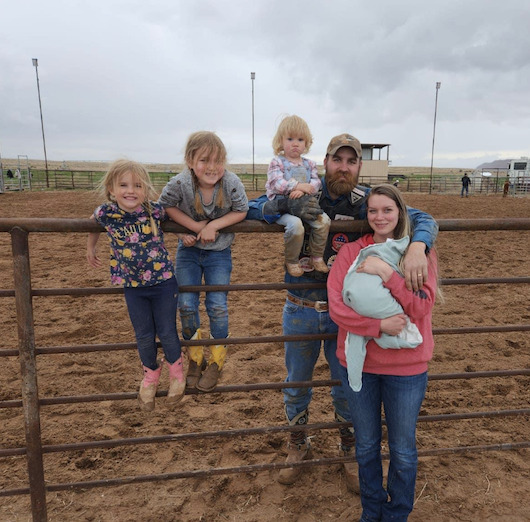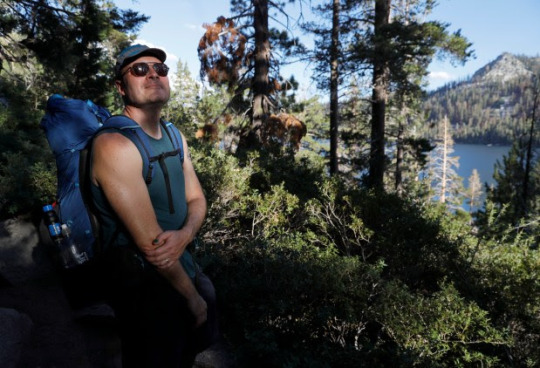#schrock family
Explore tagged Tumblr posts
Text
Breaking News: A brother for Ivy Sabina

Reba and Emos Schrock are expecting their 2nd child, a boy due Nov of 2024
2 notes
·
View notes
Text
Fundie Families and Adjacents I Follow: Wilson

William Clark Wilson "Clark"- d. January 18, 2018
Paula Denise "Denise"
The couple married in 1982. They share 9 children (8 living), 6 children-in-law, and 14 grandchildren. Clark died after a long battle with cancer.
1. Leah Allison "Allison"- May 13, 1983
2. Lana Brooke- August 19, 1990
3. Lucas William- January 30, 1993
4. Jacob Turner "Jake"- November 20, 1995, d. September 7, 2021
5. Austin Levi- April 26, 1997
6. Jonah Richard- June 27, 1998
7. Rachel L- October 31, 1999
8. Seth Micah- February 19, 2004
9. Daniel- 2007
John Silas- miscarriage
Joy- miscarriage

Allison married John Alva Miller (December 30, 1981) on May 5, 2018, at ages 34 and 36. They share 3 sons.
1. Clark James- August 15, 2019
2. Ralph Tucker- September 19, 2020
3. David Lee- September 19, 2022

Lana married James Shelby Weeks "Shelby" in 2017. They share two children.
1. Wilson James- May 11, 2018
2. Ella Katherine- September 8, 2019

Luke married Sarah Hutson (March 21, 1994) on December 2, 2017, at ages 24 and 23. They share 3 sons.
1. William Cadman- August 27, 2018
2. Archer Luke- September 9, 2020
3. Colt Walker- August 30, 2022

Jake shared a child with former girlfriend Lundyn Smith. Jake died at age 25 in a motorcycle accident.
1. John William Turner- December 31, 2020

Austin married Anna D Schrock on June 17, 2019. They share 3 daughters.
1. Summer Joelle- May 15, 2018
2. Paula Lillian- November 8, 2019
3. Rose Elena- June 24, 2022
4. Austin Dakota- March 22, 2024

Jonah married Grace Hackle (January 5, 2000) on April 10, 2022, at ages 23 and 22. They are expecting a child.
Sailor- October 4, 2023
Skye- October 4, 2023

Rachel married Daniel Clay Weeks on August 4, 2019.
2 notes
·
View notes
Text
FITNESS 19

Address:
85 West Schrock Road
Westerville, OH 43081
Phone: (614) 899-1919
Website: http://fitness19.com/centers/westerville
Fitness 19 was founded in 2003 with the goal of providing affordable, family-friendly facilities. They offer multiple locations around the U.S with state-of-the-art cardio, strength, and free weight equipment. With month-to-month membership, personal training, and challenging group classes, everyone can find an option to suit their fitness needs.
Keywords: Fitness Centers, Fitness Club, Gym
Hour: Monday - Thursday: 5:00 AM - 11:00 PM, Friday: 5:00 AM - 9:00 PM, Saturday - Sunday: 8:00 AM - 8:00 PM
1 note
·
View note
Text
"In 1942, at CPS [Civilian Public Service] camp number 21, tucked into the Columbia River Gorge near Cascade Locks, Oregon, the conscientious objectors in residence put up the rare sustained protest against the federal policy of removing Japanese Americans from the West Coast and locking them up in internment camps. Or at least they fought the aspect of it they could hope to defeat. The men battled (nonviolently) to prevent the removal of one of their number, a pacifist and conscientious objector named George Yamada, who was the only Japanese American on hand. Most of the two hundred men at the camp fought fires, built and maintained trails, and did other conservation work in the nearby Mt. Hood National Forest. Yamada, born in 1918, had grown up on a farm in Nebraska, the son of a man who had emigrated from Japan in 1902 to avoid military service.
The family was Methodist, but Yamada stopped going to services when he was twelve because
I was not impressed by the social application in daily life of Christian teachings. From that age my interpretation of the Gospel of Christ was uncompromisingly pacifist, and I was determined to carry out the pacifist premises of the Christian gospel as I perceived them.
At nineteen, chafing under his father’s authority, Yamada moved to San Francisco. There he worshipped at the Evangelical Reformed Church in the Nikkei community, where the new minister was a pacifist. At San Francisco State, one of his professors introduced him to a visiting A. J. Muste (who led the assembled in singing “God Bless America”). Yamada was certified a CO [Conscientious Objector] by his draft board and arrived at Cascade Locks two days before Pearl Harbor. He arrived in time to meet Bayard Rustin, who visited on a speaking tour for the Fellowship of Reconciliation. At Cascade Locks, Yamada read about Buddhism (his family’s faith in Japan) in the Encyclopedia Britannica with the Hollywood heartthrob Lew Ayres, famous as Dr. Kildare, who had arrived in March of 1942. A vegetarian and free thinker, Ayres risked his career for his pacifist principles and stayed only six weeks. He would eventually serve as an army medic. He was, Yamada recalled, “a man unaffected by fame.”
When the War Relocation Authority demanded that Yamada be transferred to an internment camp, he protested, and the director at Cascade Locks, Reverend Mark Schrock, refused to comply. Yamada also had the support of the other men in camp. Kermit Sheets, one of the COs, recalled:
Wow, that camp blew apart! Because here was a guy as isolated as you could be. We knew George, he was a conscientious objector, for crying out loud! He wasn’t going to send messages to Japan that would make them shoot us! The whole thing was absolutely ridiculous. Then we had loads of meetings as to how we were going to handle it when they came for George. It got extremely tense, verging on the melodramatic…wondering how many people should lie down in front of the car that was to take him away
Letters from Cascade Locks to camps around the country enlisted support from COs at those as well, including invitations for Yamada to relocate to one in Massachusetts, and a readiness, on the part of men in an Ohio camp, “to follow your lead in non-violent direct action if necessary.” Muste also weighed in. Ultimately the authorities settled for pointlessly relocating Yamada to a Mennonite camp near Colorado Springs, Colorado, where he remained for three years. During that time he spent eight days in the county jail as part of a CORE project to desegregate a local theater, after which he was transferred to the camp for incorrigibles at Germfask, Michigan.
There is a thin line sometimes between anarchism and anarchy. Marooned on Michigan’s rural Upper Peninsula adjacent to the Seney National Wildlife Refuge, the Germfask resisters demonstrated how easily radical protest can slide toward vanity and nihilism. At Germfask, some men simply refused to work while others drove foremen to distraction by doing everything slowly, partially, and wrong. Chopping down even a small tree would be a daylong project. When directed to clean out a truck platform, the men would spend the day sweeping out a portion. “We got to be experts at not working,” recalled Roy Kepler of his time at Germfask. “We became experts at digging a hole that never got dug.” The camp’s director, sensing the futility of trying to make anyone work and no doubt aware that the war was coming to an end, didn’t require anything, and in return the men tolerated their confinement. One sympathetic visitor was taken aback, just three months after the camp opened in 1944, to find
washrooms the filthiest anywhere, dining habits those of hogs, 75% of the men unshaven, unkempt and dirty, liquor being drunk in the dorms on Sunday morning at church time, almost no project work being done.
Germfask might have muddled along in this way had not the campers thoroughly antagonized their rural neighbors, in part by giving the impression that they would, “attempt to date girls in the high school library, in churches and on the street.” Things went from bad to worse when the press depicted a mutiny among idle COs lolling about on the U.P. while other American boys were fighting and dying overseas. Time ran an exposé of the “studied defiance” of the troublemakers, whom it called “guardhouse lawyers” for their skill at staying within the law while thwarting Selective Service officials. The magazine said these officials were
at their wit’s end. The problem that vexed them: how to deal with a group of draft-age Americans who have refused to fight, who now decline to work, and spend most of their waking hours finding new and more ostentatious ways of thumbing their noses at all authority.
Washington got involved, but nobody had any real answers—and meanwhile the camp descended into conflict and recrimination, with once moderate COs siding with the worst antagonists. The camp’s fourth director, a former serviceman only weeks on the job, resigned and called the CPS system “the re-establishment of slavery.”
When Kepler arrived on January 20, 1945, he recorded his impressions of a bunkhouse known as Tobacco Road, where he found a “Saturday night atmosphere of beer and mixed singing that was somehow pathetic and strained, a put-on performance to convince themselves they were Bohemian.” He told all this to the War Resisters League in New York, where an official responded with the same sort of question Selective Service officials were asking, and that parents would ask a generation later about some new young radicals:
Are they heroes, valiantly fighting a vicious set-up? Are they high-spirited pranksters, gaining a relief that keeps them sane? Are they psychopaths, revealing symptoms that need treatment?
To the extent that Americans respected “conchies,” it was because they stood on conscience. But many at Germfask belied the stereotype of devout war resisters too religious to kill. The crowded and smoky Tobacco Road dorm, so dubbed after Erskine Caldwell’s 1932 novel of backroads dissolution, featured late night poker games, a coffee pot going all the time, food lifted from the mess hall, and nude pinups all over the walls. Some Germfask campers took their campaign against sainthood into the surrounding communities. Delivered to the nearby town of Munising for a bit of leave, they disabled their vehicle by tampering with the engine and then got drunk at the local bars, where one got into a fight with a soldier outside.
A campaign of vandalism and sabotage at Germfask included clogging toilets, hiding light bulbs and silverware, and spreading an inch of flour on a floor, the better to write obscenities on it in coffee grounds. An even more embarrassing episode occurred on the night of January 30, when some of the men broke into the kitchen and, in a time of national food rationing, made a shambles of the place, dumping a hundred-pound bag of beans, a three-gallon jar of mustard, seven quarts of orange and lemon extract, and thirty pounds of baking powder. They smashed or removed bulbs and oven doors, and in the cooler blended stewed apricots and prunes with steamed rice.
...
At Germfask, Yamada fell in with a militant group of resisters including the soon-to-become-notorious Corbett Bishop. After taking part in a work slowdown, Yamada (with others) walked away from camp, earning himself a prison sentence of three and a half years. At Ashland, Kentucky, where he was sent off to do his time, he was reunited with Rustin."
- Daniel Akst, War By Other Means: How the Pacifists of World War 2 Changed American for Good. New York: Melville House, 2022. p. 176-179.
#civilian public service#conscientious objectors#pacifism#world war ii#united states history#work camp#nonviolent resistance#japanese american internment#japanese americans#nonviolence#research quote#reading 2024#fellow for reconciliation#racism in america#anti-racism#incorrigbles#penal colony#nikkei amerikajin
1 note
·
View note
Link
0 notes
Text
Indigene Kunstgalerie im Baltimore Center Stage eröffnet

In Baltimore wurde eine neue Galerie für indigene Kunst eröffnet, die das Ergebnis einer Partnerschaft zwischen dem Baltimore American Indian Center (BAIC) und dem Baltimore Center Stage (BCS) ist. Die Indigenous Art Gallery at Baltimore Center Stage zeigt einige der zeitgenössischen indianischen Künstler der Region und unterstreicht die Tatsache, dass "indianische Menschen immer noch hier sind, dass indianische Menschen vielfältig sind und dass indianische Kunst und Praktiken durch die Zeit hindurch miteinander verbunden sind", heißt es in der Pressemitteilung zur Eröffnung. "Die Indigenous Art Gallery macht ausgelöschte Geschichten sichtbar und ehrt gleichzeitig die Traditionen und das Vermächtnis der Völker von Piscataway, Susquehannock, Lenape und Lumbee sowie der vielen indigenen Völker, die sich heute um unsere Ländereien und Wasserwege kümmern", sagte Annalisa Dias, Direktorin für künstlerische Partnerschaften und Innovation bei BCS. "Wir sind dem Baltimore American Indian Center sehr dankbar für die vertrauensvolle Zusammenarbeit bei diesem Projekt und anderen Projekten. Wir freuen uns darauf, unsere Zusammenarbeit in den kommenden Jahren weiter zu vertiefen."

"Indigene Kunst verkörpert Dekolonisierung, umfasst Geschichte, Vergangenheit, Gegenwart, Zukunft, Familie, wirtschaftlich marginalisierte Gemeinschaften und stellt sich Umweltfragen durch ein Gleichgewicht von Schönheit, Tradition und Innovation", sagte Tomalita Peterson, Vorstandssekretärin des Baltimore American Indian Center. "Wir fühlen uns zutiefst geehrt, dass wir die Möglichkeit haben, Seite an Seite mit der Baltimore Center Stage zu arbeiten, um einige unserer besten zeitgenössischen indianischen Künstler zu präsentieren." Mit der neuen Galerie soll die BCS-Politik der Landanerkennung in die Praxis umgesetzt werden. Die Anerkennung des Landes ehrt die traditionellen indigenen Verwalter des Landes, auf dem sich das Theater befindet, sowohl zu Beginn öffentlicher Veranstaltungen als auch in schriftlichen Unterlagen für die Öffentlichkeit. "Sie ist mehr als nur eine symbolische Geste; sie zeigt die lebendigen und vielfältigen Werke zeitgenössischer indigener Künstler in der Gemeinde Baltimore und hebt ihre einzigartigen Perspektiven und kreativen Ausdrucksformen hervor. BCS hat mit den Partnern des BAIC zusammengearbeitet, um die Beziehungen zu lokalen indianischen Künstlern zu vertiefen", heißt es in der Pressemitteilung. Die Galerie zeigt Werke der Künstler Judy TallWing (Apache), Ashley Minner (Lumbee Tribe of North Carolina), Joshua Webster (Lumbee Tribe of North Carolina), Dean Tonto Cox (Lumbee Tribe of North Carolina) und Tanelle Schrock (Lumbee Tribe of North Carolina). "Baltimore Center Stage ist bestrebt, ein Knotenpunkt zu sein, an dem Menschen mit unterschiedlichem Hintergrund aus den vielen Gemeinschaften im Großraum Baltimore zusammenkommen und durch Kunst eine kulturelle Heimat finden können. Mit dieser Mission erkennen wir als Institution die Verantwortung an, diesen Raum zu einem Ort zu machen, an dem indigene Kulturträger, Künstler, Kunsthandwerker, Macher und ihre Verwandten gedeihen können", fügte Adam Frank, Managing Director bei BCS, hinzu. Lesen Sie hier den Originalartikel. Weitere Informationen: Centerstage.
Was Sie auch noch interessieren könnte
https://youtu.be/WETXK0ZNmyY?si=mnxIRxRJNnGihfnX Read the full article
0 notes
Text
Revamp Your Home with the Best Kitchen Cabinet Shops in New Jersey
The kitchen is often referred to as the heart of the home, and for good reason. It's where we prepare meals, share stories, and create memories with our loved ones. As such, it's crucial that the kitchen is not only functional but also aesthetically pleasing. One way to achieve this is by upgrading your kitchen cabinets. If you're in New Jersey, you're in luck as there are numerous kitchen cabinet shops that offer a wide range of options to fit your style and budget. In this article, we'll explore some of the best kitchen cabinet shops in New Jersey and what they have to offer.

Kitchen & Bath Gallery
Kitchen & Bath Gallery is a family-owned business that has been providing high-quality kitchen and bath cabinetry since 2003. They offer a wide range of custom cabinets from some of the top manufacturers in the industry, including HM Cabinet, Merillat, and Diamond. They also have their own line of custom cabinets that are made to order, allowing you to create a unique look that reflects your personal style. They have showrooms in Marlboro and West Long Branch, where you can see their products in person and get expert advice from their design team.
Direct Depot Kitchen Wholesalers
Direct Depot Kitchen Wholesalers is one of the largest kitchen cabinet shops in New Jersey, with over 20 years of experience in the industry. They offer a huge selection of cabinets from some of the top brands in the industry, including HM Cabinet, Fabuwood, and Wolf. They also have their own line of cabinets that are made in the USA and come with a lifetime warranty. They have showrooms in Little Falls and Clark, where you can see their products in person and get expert advice from their design team.
Cabinets Direct USA
Cabinets Direct USA is a one-stop-shop for all your kitchen cabinet needs. They offer a wide range of cabinets from some of the top brands in the industry, including Schrock, HM Cabinet, and Fabuwood. They also have their own line of cabinets that are made in the USA and come with a lifetime warranty. They have showrooms in Paramus, new jersey, Wayne, and Toms River, where you can see their products in person and get expert advice from their design team.
Bella Kitchen & Cabinetry
Bella Kitchen & Cabinetry is a family-owned business that has been providing high-quality kitchen cabinets since 1996. They offer a wide range of custom cabinets that are made to order, allowing you to create a unique look that reflects your personal style. They also have a selection of cabinets from some of the top brands in the industry, including Dura Supreme, HM Cabinet, and Ultracraft. They have showrooms in Robbinsville and Middletown, where you can see their products in person and get expert advice from their design team.
Kitchen Magic
0 notes
Text
Bumpin': The Modern Guide to Pregnancy: Navigating the Wild, Weird, and Wonderful Journey From Conception Through Birth and Beyond - Leslie Schrock
EPUB & PDF Ebook Bumpin': The Modern Guide to Pregnancy: Navigating the Wild, Weird, and Wonderful Journey From Conception Through Birth and Beyond | EBOOK ONLINE DOWNLOAD
by Leslie Schrock.

Download Link : DOWNLOAD Bumpin': The Modern Guide to Pregnancy: Navigating the Wild, Weird, and Wonderful Journey From Conception Through Birth and Beyond
Read More : READ Bumpin': The Modern Guide to Pregnancy: Navigating the Wild, Weird, and Wonderful Journey From Conception Through Birth and Beyond
Ebook PDF Bumpin': The Modern Guide to Pregnancy: Navigating the Wild, Weird, and Wonderful Journey From Conception Through Birth and Beyond | EBOOK ONLINE DOWNLOAD Hello Book lovers, If you want to download free Ebook, you are in the right place to download Ebook. Ebook Bumpin': The Modern Guide to Pregnancy: Navigating the Wild, Weird, and Wonderful Journey From Conception Through Birth and Beyond EBOOK ONLINE DOWNLOAD in English is available for free here, Click on the download LINK below to download Ebook Bumpin': The Modern Guide to Pregnancy: Navigating the Wild, Weird, and Wonderful Journey From Conception Through Birth and Beyond 2020 PDF Download in English by Leslie Schrock (Author).
Description Book:
?A smart, approachable guide packed with practical advice for parents who want a science-backed, individualized approach to pregnancy.? ?Linda Avey, Co-founder of 23andMe 2020 National Parenting Award WinnerFeeling overwhelmed? Confused by conflicting advice? Bumpin? will radically transform your pregnancy journey to one of confidence and optimism. With over a decade of experience advising women?s healthcare and technology companies, Leslie Schrock distills cutting-edge research into your most comprehensive pregnancy guide?from conception through the newborn months. Based on the latest clinical evidence and practical advice from top experts, Bumpin? enables you to make the best decisions for your unique family. With a look at the science, it tackles every pregnancy FAQ and topics like the truth about cleaning up your cosmetics, nutrition, epidurals, and activity; and the practical, like putting together a baby budget and navigating work. Bumpin? also takes you all the way through the
0 notes
Text
Book Review: The Sunday Singing by Hannah Schrock
Book Review: The Sunday Singing by Hannah Schrock
The Sunday Singing by Hannah SchrockMy rating: 5 of 5 starsKindleSinging as we goA nice little story with community and family dynamics. She was so frustrated she almost ran off with the Englisher! I believe God intervened there and sent her home. Thanks for another quick look at Amish living.View all my reviews Amazon Anna loved attending the Sunday Singings, but she could never accept the…

View On WordPress
0 notes
Photo

#ed schrock#republicans#gay prostitution#solicitation#homophobe#gay chat line#family values#republican hypocrisy
121 notes
·
View notes
Text
Breaking News: Baby Schrock is here

Josaphina Ruth Schrock was born Oct 15th 2023 to Andrew and Hannah Schrock
6 notes
·
View notes
Text
Fundie Families and Adjacents I Follow: Pearl

Michael
Debi
Michael and Debi married in 1971. They share 5 children, 5 children-in-law, and 27 grandchildren, 2 grandsons-in-law, and 1 great-granddaughter.
Rebekah- 1975ish
Gabriel- October 2, 1976
Nathan- October 5
Shalom- September 27
Shoshanna- September 13, 1983
------------------------------------------------------------------------

Rebekah married Gabe Anast. They share 6 children
Joseph Courage- 2001
Ryshoni Joy
Hannah Sunshine
Elijah Music
Chaiyah Eve
Alitsia Rin
------------------------------------------------------------------------

Gabriel married Elizabeth Schrock (March 25) on April 12. 2017. Gabe had 4 children from a previous marriage with a woman named Lori Munsell. They married on September 1, 2004 and were married until early 2017. He shares 2 children with Elizabeth.
Jocelyn Nicole- October 27, 2004
Laife
Joshua Gabriel
Liam- March 21, 2013
Eden Rain- September 2018
Daniel- 2021
------------------------------------------------------------------------

Nathan married Zephyr Zajicek (1981) on January 14, 2001. They share 5 children and a son-in-law.
Laura Rose- November 18, 2002
Ashley- 2005ish
Son- September 12, 2006
Gideon Levi- July 4, 2008
Child

Laura married Jadon Martin (1998) on July 18, 2021.
Aurora Lei- August 18, 2024
------------------------------------------------------------------------

Shalom married Justin Brand. They share 6 children and a son-in-law.
Janelle Grace- 2004
Laila Truth- 2007
Parker Ford- November 2011
Roland- June 10, 2012
Hudson- 2015
Ryder- February 2017

Janelle married Levi Taylor in 2022.
------------------------------------------------------------------------

Shoshanna married James Easling. They share 4 children but are now divorced.
Jeremiah James- August 22, 2005
Penelope Jane- August 20, 2010
Lincoln Michael- June 27, 2017
Girl- 2020

Jeremiah engaged to Ashlynn Taylor Dixon.
1 note
·
View note
Text
Review: The Amish Orphan
Review: The Amish Orphan
Rating: 5-stars Review: The Amish Orphan by Hannah Schrock is a beautifully told Amish story. This novella brings out the true Amish way of living, their faith, and the tug of war on my heart strings. I laughed and I cried while reading this book. I have never read this writer’s work before until now. I cannot post a synopsis of the book because I cannot find one. This must be an old copy I…

View On WordPress
#Amazon#Amish#Amish Fiction#clean read#Engaging#entertaining#faith#family#friends#Goodreads#grief#Hannah Schrock#Harlequin#Heartfelt#hope#humor#inspired romance#loss#love#must read book#new#recommended#romance#sad#The Amish Orphan
0 notes
Text
Flee for Your Life? Wildfires transform hiking in California's mountains
This is an excerpt from an article published on August 21, 2022 in the Santa Cruz Sentinel. I wish so many of our posts were not related to wildfires but fires have become a critical issue in trip planning and trip safety. Make sure you read to the recommendations at the end of the piece.
By Ethan Baron
Andrew Schrock woke around midnight smelling smoke on a backpacking trip late last month in California’s far north.
“I heard what I thought was rain but was ashes on the tent,” said Schrock, 43.
Using a satellite-based device from the Klamath National Forest near the Oregon border, he texted family and friends back home to find out what was happening – but “no one was up.”
He’d had cell service a mile back along the iconic Pacific Crest Trail that stretches from Mexico to Canada, so he set out alone in the dark, got online, and discovered that the McKinney Fire – which has since grown to more than 60,000 acres, killed four people and required the rescue of 60 hikers from the California side of the trail – had ignited behind him to the south the previous afternoon.
Ask anyone who hikes in California’s mountains about wildfires and you’ll likely get an earful about canceled trips, detours, lung-burning smoke and, possibly, harrowing escapes. Backcountry travelers are increasingly finding themselves on the dangerous edge of a changing climate that is driving drought, parching forests, spreading tree-killing beetles and altering weather patterns. Add in heavy vegetation buildup from decades of fire suppression, and you have frequent, ferocious forest fires that scramble hikers’ best-laid plans and demand new tactics for staying safe.

Schrock, of Long Beach, flew from Ashland, Oregon, to Fresno and then caught a bus to Yosemite to get back into the Sierra Nevada and finish his vacation covering more ground and enjoying the wilderness on his multi-year quest to complete the Pacific Crest Trail, he recalled while taking a snack break beside Lower Echo Lake near Lake Tahoe.
Dallan Clancy of Belmont, 68, finishing up a day hike 100 miles west of Sacramento at Carson Pass, said he had to cancel an overnight trip last September in the southern Sierra because the U.S. Forest Service shut access to all but one of California’s national forests over fire risks, including what the agency called “fire behavior that is beyond the norm of our experience and models such as large, quick runs in the night.” Clancy said he and four friends are aiming to do the trip this year, “unless it gets really bad.”
“We’ve always made note of escape routes, but on this trip, we actually planned our escape routes. We wanted to know the routes we could take to get out to a road,” said Jack Daro, a Southern California musician taking a break at Carson Pass during a backpacking trek to Yosemite National Park.

Hikers in years past “just went and did whatever you wanted to do wherever you wanted to go,” Wilkinson said. But 2020 marked a transformation, with the million-acre August Complex Fire, the Creek Fire northeast of Fresno that led to helicopter evacuations of hundreds of people including hikers on the John Muir Trail, and other massive blazes launching California into the age of mega-fires, Wilkinson said.
Nine of California’s 20 biggest fires since 1932 have occurred in the past three years, torching 4.1 million acres, according to Cal Fire. This year’s five biggest blazes have burned 116,000 acres, and “we’re just now getting into peak wildfire season,” Wilkinson said.
U.S. Forest Service spokeswoman Adrienne Freeman noted that fire can move much faster in today’s baked-crisp forests. “The window between OK and not OK,” Freeman said, “is becoming shorter and shorter.”
Backcountry journeyers who think seeing smoke but no flames means they’re fine may be mistaken, Wilkinson said. “Fire can move like a freight train, much faster than a person can run.”
Some hikers have dramatically changed the way they travel. Loetitia Saint-Jacques, 50, a Tahoe City veterinary technician, was on an overnight trip this month near South Lake Tahoe. Before the mega-fires, she and her companions would take long trips into deep wilderness. “We don’t go as remote now,” Saint-Jacques said. “Now it’s shorter trips. We do overnights, instead of five to eight days.”
Long-distance speed-hiker Ella Raff had multiple run-ins with wildfire and its fallout after embarking on the Pacific Crest Trail in June to walk from Mexico to Canada. Last month, the Washburn Fire in Yosemite shrouded her in smoke for two days. “I was just breathing heavy smoke 24/7. It’s not very fun,” said Raff, 29, of Portland. Farther north in California, traversing 85 miles of trail charred from last year’s nearly million-acre Dixie Fire left Raff covered in ash and dismayed by a “surreal” landscape with little animal life.

Soon after, she smelled smoke from the McKinney Fire. As she was nearing the Oregon border, authorities shut the trail ahead. More than 100 miles of the route remain closed, with the fire, which started July 29, now almost contained. Raff made her way to Portland, then to Washington to hike the trail southward from Canada.
Changing jumping-off points, routes, destinations, or timing to cope with uncertainty about fires is now routine for hikers in California. The Caldor Fire, which ravaged 220,000 acres southwest of Lake Tahoe last year from August to October, forced Truckee artist Danae Anderson, 63, to cancel three backpacking trips. “Everything was too smoky up here,” said Anderson, hiking beside Lower Echo Lake. She went to Yosemite instead.
Reckless target shooting by a father and son allegedly caused the Caldor Fire. The inferno’s scar stretches nearly 50 miles southwest of Echo Lakes in a swath up to 15 miles wide, much of it a blackened wasteland of lifeless trees, some downed, some standing without greenery, granite on many boulders shattered in places by the intense heat. More than 80 miles of the Pacific Crest Trail were closed from the fire’s start last August until early this year. Hikers passing through such areas may find water scarce, and standing dead trees can pose a deadly toppling hazard, said Matt Rump, a trail stewardship staffer for the Pacific Crest Trail Association.
Crews take down the most dangerous trees, but because there are so many dead, and they provide important wildlife habitat, officials accept some risk to hikers, under the calculus that “if you get whacked, it’s your time,” said Cheryl Bailey, 73, a volunteer for the Tahoe Rim Trail Association, as she walked along the 2 1/2 miles of the rim trail that run through the Caldor scar and that she’s been helping rebuild.
Some hikers console themselves with fire’s importance to forest health, but many of today’s blazes burn so hot they kill trees accustomed to lower-intensity fires.
In the Echo Chalet store where Schrock, who fled the McKinney Fire, bought snacks, cashier Georgia Sprague, 22, chatted with the trekkers whose ebbs and flows depend on fires and smoke. Many expressed urgency over climate change.
“They feel a lot of a push to get out,” she said, “and see the world before it burns up.”
Wildfire safety tips for hikers
Recommendations for staying safe while hiking in the age of mega-fires:
Check websites such as InciWeb for fire information and PurpleAir for air-quality information before, and if possible during, backcountry trips.
2. Give friends and family your itinerary, always know your location and pay close attention to your surroundings in case you need to retreat.
3. Know whether fires are prohibited where you’re going.
4. Carry paper maps in addition to any digital maps or apps.
5. Use cell phones and satellite-based devices to monitor weather, fires, wind, air quality and alerts such as Red Flag wildfire warnings, and to stay in close contact with people not in the wilderness who may have better access to weather and fire information. Many satellite-based messaging devices such as the popular Garmin inReach also act as rescue beacons; trekkers wishing to stay less connected may prefer personal locator beacons that are only for emergency rescue.
6. Pay attention to signs at trailheads and trail junctions.
7. Gather crowd-sourced fire and trail information from reliable websites and forums.
8. Carry an N95 mask in case of smoke.
9. Watch the sky for smoke, and use your nose to detect it.
27 notes
·
View notes
Link
OPEN HOUSE, Saturday, July 1st, 11 am to 1 pm 494 Rulison Drive at Bayles Lake in Loda, IL
0 notes
Photo

August 1939: "Washington, Yakima Valley, near Wapato. One tenant purchase program (Farm Security Administration) client, Jacob N. Schrock. This family with eight children had lived for 25 years on a rocky, rented farm in this valley. They now own 48 acres of good land, this good house, price $6,770. They raise hay, grain, dairy and hogs. Mrs. Schrock says, 'Quite a lot of difference between that old rock pile, and around here'."
18 notes
·
View notes